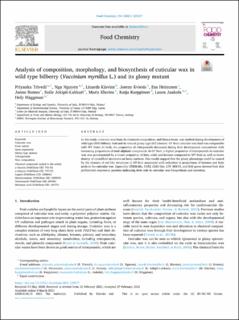| dc.contributor.author | Trivedi, Priyanka | |
| dc.contributor.author | Nguyen, Nga | |
| dc.contributor.author | Klavins, Linards | |
| dc.contributor.author | Kviesis, Jorens | |
| dc.contributor.author | Heinonen, Esa | |
| dc.contributor.author | Remes, Janne | |
| dc.contributor.author | Jokipii-Lukkari, Soile | |
| dc.contributor.author | Klavins, Maris | |
| dc.contributor.author | Karppinen, Katja | |
| dc.contributor.author | Jaakola, Laura | |
| dc.contributor.author | Häggman, Hely | |
| dc.date.accessioned | 2021-10-20T08:43:02Z | |
| dc.date.available | 2021-10-20T08:43:02Z | |
| dc.date.created | 2021-07-15T14:28:43Z | |
| dc.date.issued | 2021-03-09 | |
| dc.identifier.citation | Food Chemistry. 2021, 354 . | en_US |
| dc.identifier.issn | 0308-8146 | |
| dc.identifier.uri | https://hdl.handle.net/11250/2824030 | |
| dc.description.abstract | In this study, cuticular wax load, its chemical composition, and biosynthesis, was studied during development of wild type (WT) bilberry fruit and its natural glossy type (GT) mutant. GT fruit cuticular wax load was comparable with WT fruits. In both, the proportion of triterpenoids decreased during fruit development concomitant with increasing proportions of total aliphatic compounds. In GT fruit, a higher proportion of triterpenoids in cuticular wax was accompanied by a lower proportion of fatty acids and ketones compared to WT fruit as well as lower density of crystalloid structures on berry surfaces. Our results suggest that the glossy phenotype could be caused by the absence of rod-like structures in GT fruit associated with reduction in proportions of ketones and fatty acids in the cuticular wax. Especially CER26-like, FAR2, CER3-like, LTP, MIXTA, and BAS genes showed fruit skin preferential expression patterns indicating their role in cuticular wax biosynthesis and secretion. | en_US |
| dc.language.iso | eng | en_US |
| dc.publisher | Elsevier Ltd. | en_US |
| dc.rights | Attribution-NonCommercial-NoDerivatives 4.0 Internasjonal | * |
| dc.rights.uri | http://creativecommons.org/licenses/by-nc-nd/4.0/deed.no | * |
| dc.title | Analysis of composition, morphology, and biosynthesis of cuticular wax in wild type bilberry (Vaccinium myrtillus L.) and its glossy mutant | en_US |
| dc.type | Peer reviewed | en_US |
| dc.type | Journal article | en_US |
| dc.description.version | publishedVersion | en_US |
| dc.rights.holder | © 2021 The Author(s) | en_US |
| dc.source.pagenumber | 9 | en_US |
| dc.source.volume | 354 | en_US |
| dc.source.journal | Food Chemistry | en_US |
| dc.identifier.doi | 10.1016/j.foodchem.2021.129517 | |
| dc.identifier.cristin | 1921868 | |
| dc.relation.project | EC/H2020/713606 | en_US |
| dc.source.articlenumber | 129517 | en_US |
| cristin.ispublished | true | |
| cristin.fulltext | original | |
| cristin.qualitycode | 1 | |

